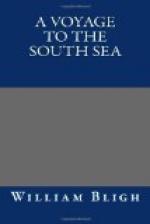We continued to have the southern oceanic birds accompany us and a few whales. The people caught albatrosses and fattened them in the same manner which they had done when off Cape Horn. Some of these measured near eight feet between the tips of the wings when spread.
Thursday 9.
On Thursday the 9th we had the misfortune to lose one of our seamen, James Valentine, who died in the night of an asthmatic complaint. This poor man had been one of the most robust people on board until our arrival at Adventure Bay, where he first complained of some slight indisposition for which he was bled, and got better. Some time afterwards the arm in which he had been bled became painful and inflamed: the inflammation increased, with a hollow cough, and extreme difficulty of breathing, to his death.
Monday 13.
The 13th in the afternoon we saw two land birds like what are called sand-larks. Our latitude at this time was 28 degrees 3 minutes south and longitude 223 degrees 26 minutes east.
Tuesday 14.
The next morning we saw a tropic bird and some fish. The winds were light and variable with calms from this time to the 19th, when a breeze sprang up from the north-east, which gradually came round to the eastward and proved to be the tradewind. Our latitude on the 19th at noon was 24 degrees 13 minutes south, longitude 222 degrees 17 minutes east. Variation of the compass 5 degrees 19 minutes east.
Saturday 25.
On the 25th at half-past seven in the morning we saw the Island Maitea, called Osnaburg by Captain Wallis, who first discovered it. At noon it bore south-west by west one-quarter west, six miles distant. Our latitude 17 degrees 50 minutes south, longitude 212 degrees 24 minutes east. Variation five degrees east. As Captain Wallis and Captain Cook had both passed near the south side, I ran along the north side, which is remarkably steep. The island is high and round and not more than three miles in its greatest extent. The south side, where the declivity from the hill is more gradual, is the chief place of residence of the natives; but the north side, from the very summit down to the sea, is so steep that it can afford no support to the inhabitants. We steered pretty close in to the northward of the east end, where we saw but few habitations: a very neat house on a small eminence, delightfully situated in a grove of coconut-trees, particularly attracted our notice. About twenty of the natives followed us along shore, waving and showing large pieces of cloth; but the surf on the shore was too high to think of having any communication with them. I observed a great number of coconut-trees but did not see one plantain-tree. There were other trees but of what kind we could not distinguish: near the east end are two remarkable rocks, and a reef runs off to the eastward about half a league.
The latitude of Maitea is 17 degrees 53 minutes south; and by our timekeeper its longitude is 1 degree 24 minutes east from Point Venus. Variation of the compass 5 degrees 36 minutes east.




